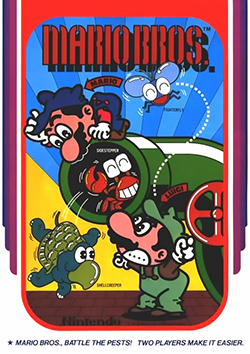Mario Bros.
| Mario Bros. | |
|---|---|

American arcade flyer
|
|
| Developer(s) | Nintendo Research & Development 1 |
| Publisher(s) |
|
| Designer(s) |
Shigeru Miyamoto Gunpei Yokoi |
| Composer(s) | Yukio Kaneoka |
| Series | Mario franchise |
| Platform(s) |
Arcade
|
| Release date(s) |
July 14, 1983
|
| Genre(s) | Platforming |
| Mode(s) | Single-player, multiplayer |
| Cabinet | Upright |
| CPU |
Zilog Z80 @ 3.072 MHz I8039 @ 0.73 MHz |
| Sound | DAC, samples |
| Display | Horizontal orientation, raster, 256 × 224 resolution |
| Review scores | |
|---|---|
| Publication | Score |
| AllGame |
|
| GameSpot | 4.9/10 (Virtual Console) |
| IGN | 4.5/10 (Virtual Console) 6/10 (e-Reader) |
Mario Bros. (マリオブラザーズ Mario Burazāzu?) is a platform game published and developed for arcades by Nintendo in 1983. It was created by Shigeru Miyamoto. It has been featured as a minigame in the Super Mario Advance series and numerous other games. Mario Bros. has been re-released for the Wii's, Nintendo 3DS's, and Wii U's Virtual Console services in Japan, North America, Europe and Australia.
In the game, Mario is portrayed as an Italian-American plumber who, along with his younger brother Luigi, has to defeat creatures that have been coming from the sewers below New York City. The gameplay focuses on Mario's extermination of them by flipping them on their backs and kicking them away. The original versions of Mario Bros.—the arcade version and the Family Computer/Nintendo Entertainment System (FC/NES) version—were received positively by critics.
Mario Bros. features two plumbers, Mario and Luigi, having to investigate the sewers of New York after strange creatures have been appearing down there. The objective of the game is to defeat all of the enemies in each phase. The mechanics of Mario Bros. involve only running and jumping. Unlike future Mario games, players cannot jump on enemies and squash them, unless they were already turned on their back. Each phase is a series of platforms with pipes at each corner of the screen, along with an object called a "POW" block in the center. Phases use wraparound, meaning that enemies and players that go off to one side will reappear on the opposite side.
...
Wikipedia
